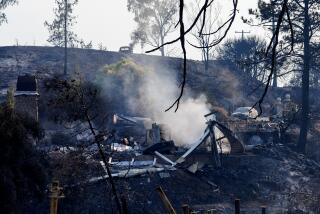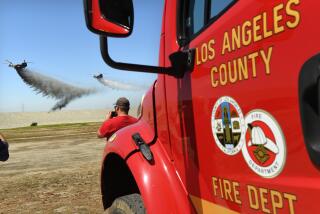Chiefâs hiring raised hopes
He was to be the architect of a remade Los Angeles Fire Department. Popular and polished, William Bamattre seemed to possess the political smarts and academic pedigree to force reform on a department considered progressive technologically but riven by gender-based discrimination and racial hostility.
Now, after 11 years as the departmentâs chief, Bamattre is being pilloried by politicians, firefighters and community activists as an ineffective and uninspiring leader, and may be on the verge of being forced from office by the very sorts of controversies that won him the job of chief.
If he leaves, more than one year shy of his planned retirement date, it will be the fallout from an acrimonious public battle over a black firefighterâs racial harassment lawsuit.
In 1995, Bamattre, then 43, rode a similar controversy into office. He succeeded 39-year veteran Donald Manning, who was forced to resign after weeks of council hearings into claims that female and black firefighters were being driven from the department by harassment and fire station hostility.
Bamattre had a single mandate: Change the culture. His priority, he said then, was to restore public confidence in the department.
âHe was clearly the best choice,â said former Mayor Richard Riordan, who hired him. âPeople liked him, people respected him. He was the only person we could find who fit the bill: getting people to get along. He had the personality and the feel for it.â
Bamattre had grown up in Baldwin Hills, attended schools in the Crenshaw and Fairfax districts, and earned a degree in political science from Stanford University. It was there that he decided to become a firefighter after working to help pay his tuition on the universityâs Fire Department. He started working for the Los Angeles Fire Department in January 1976.
Later, he earned a masterâs degree in public administration from Cal State L.A. and pursued a political career. In 1989, he was elected to the City Council of the newly incorporated city of Dana Point; in 1991, he became its mayor.
Bamattre started strong as chief. He ordered an independent study of harassment and discrimination and put hiring on hold for two years to revamp recruitment and training in an effort to attract and keep more women and minorities.
He had an academicâs sensibilities, a view that institutional change ought to happen organically. âI wanted to change the attitude of the department as it relates to change itself,â he said Wednesday. âInstead of resisting change, to recognize that change is inevitable.â
But he found himself between a rock and a hard place. Veteran white firefighters complained that standards had been lowered to hire women and to meet the goals imposed by a consent decree that mandated the hiring of more minorities.
Diversity has increased -- particularly in the departmentâs management ranks -- during Bamattreâs tenure. But conflict -- between men and women, whites and blacks, management and the rank and file -- seems to have intensified. Instead of pushing the issue, Bamattre seems to have retreated.
âHe was supposed to be an agent of change,â said Armando Hogan, president of the Stentorians, a group representing black firefighters. âHe was going to make it more inclusive, more diverse.... But when he met resistance, what did he do?â
Not enough, his critics say.
In a letter to Mayor Antonio Villaraigosa this month, local NAACP leaders demanded his firing.
âChief Bamattre was given the opportunity to root out the racism and the sexism in the department and had over a decade to do so,â the letter said. âUnfortunately [he] did not take this responsibility seriously.â
Bamattre insists that he took a hard line against hazing and harassment, âbut each individual wants to draw their own line about whatâs appropriate and whatâs not.â He inherited a disciplinary system that made it difficult for him to punish offenders appropriately, he said.
But some who worked with Bamattre say he could have done more to enforce the departmentâs zero-tolerance policy, that he never seemed to grasp the magnitude of the brewing problem.
âHeâs got a good moral and ethical compass. Heâs very bright. Heâs not a racist,â said fire Commissioner Genethia Hudley-Hayes. âHe just doesnât like the discipline aspect. I think he believes that folks ought to know how to police themselves.... I think he doesnât believe thatâs his job.
âBut when youâre running a department that has [this] history and culture, you need to take the velvet glove off and take the hammer in your hand and say no more.â
Many blame his management team for allowing problems to fester. Deputy chiefs sometimes failed to investigate complaints promptly or fairly, or didnât bring them to Bamattreâs attention.
Unlike Police Chief William J. Bratton, Bamattre never used the bully pulpit to try to bring wayward employees in line. And observers say he waited too long to take the initiative in making the changes he said he needed.
âHeâs a nice guy, and heâs not a strong leader,â said City Controller Laura Chick, whose audit of the department earlier this year found low morale and widespread perceptions of discrimination.
âHe doesnât like confrontation. Heâs a professional firefighter, and on the operational side, heâs very good.â
Chick said she feels betrayed that Bamattre presided so quietly over an organization that he acknowledges now has ongoing problems with hazing and discrimination.
âHe should have come forward and said, âWe have problems. We need to talk about them,â â Chick said. âWhy did he need an audit? Why does he need lawsuits?
âWhy didnât he go to every single fire station and sit with them and look at them and say, âHazing is going to stop, and this is how and this is why. Any command officer at any station who doesnât report hazing directly to me is going to be sent to Siberia.â â
*
More to Read
Sign up for Essential California
The most important California stories and recommendations in your inbox every morning.
You may occasionally receive promotional content from the Los Angeles Times.










